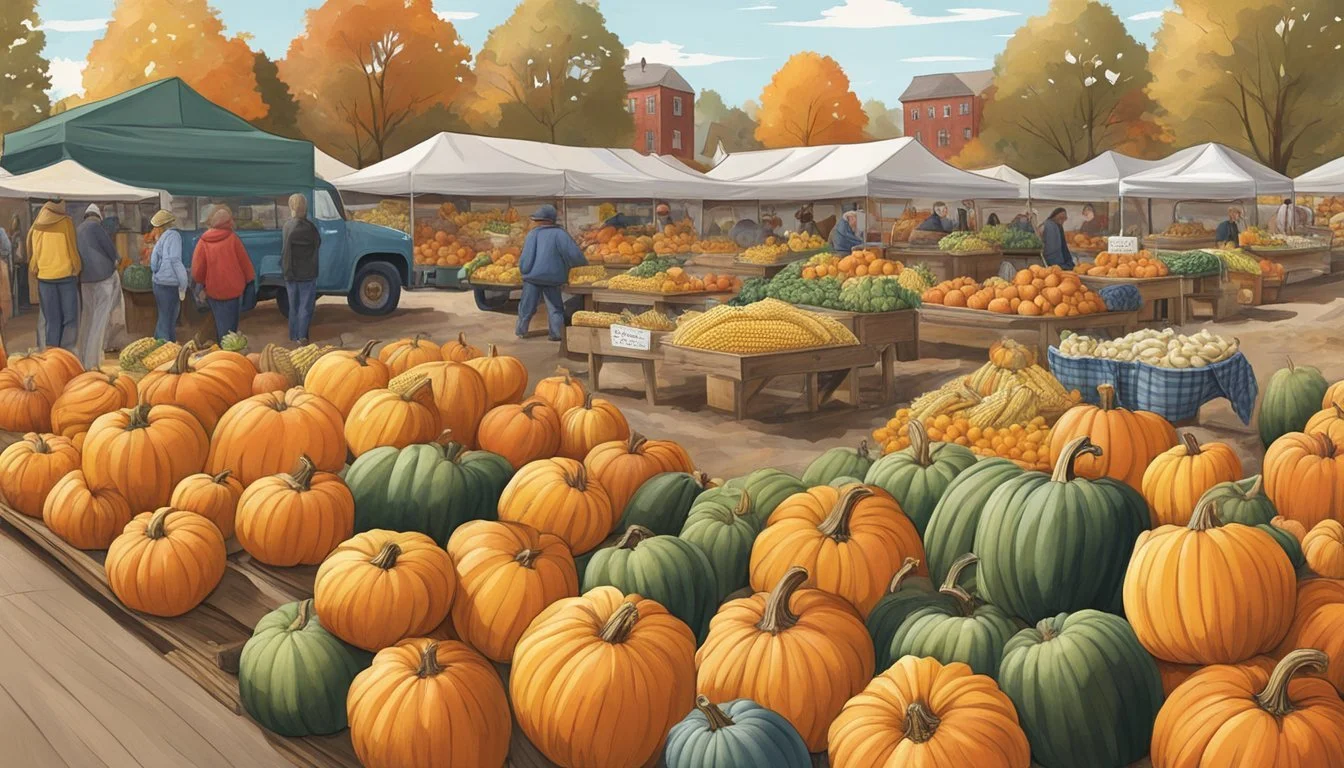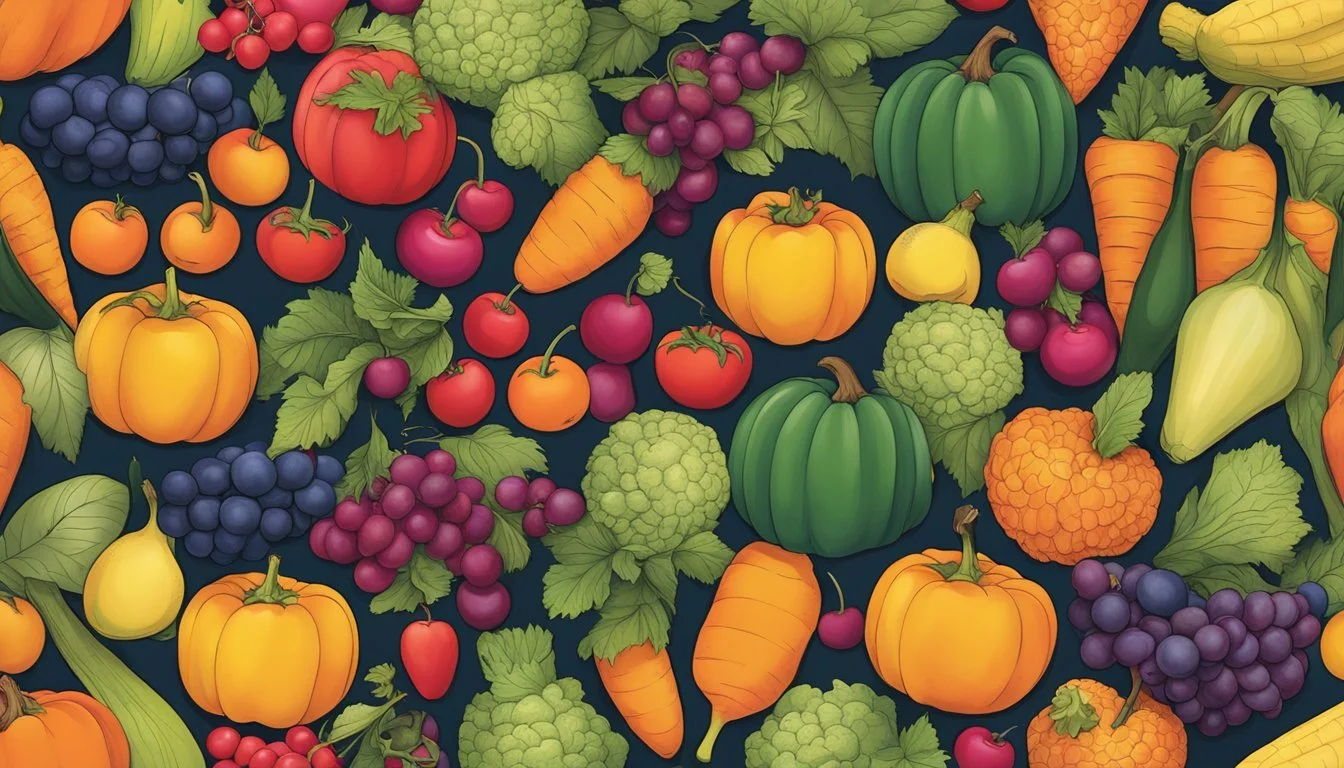New Hampshire Seasonal Fruit & Vegetables in October
A Harvest Guide
This Article is Part of our New Hampshire Seasonal Fruit & Veg Calendar
In the crisp autumn month of October, New Hampshire's landscape is not only changing colors but also offering an abundance of seasonal produce. The cooler temperatures and shorter days provide the ideal conditions for a variety of fruits and vegetables to reach their peak. Local farmers and gardeners harvest a wealth of produce, which includes a selection of both late-summer varieties and traditional fall crops.
This time of the year in New Hampshire sees the harvest of fruits such as apples, with varieties like Empire and Golden Delicious being particularly noteworthy. These apples are known for their firmness and sweetness, making them excellent for both fresh eating and pie baking. October's harvest also extends to vegetables, with an array of hearty options available. Root vegetables like potatoes and carrots, as well as cruciferous crops like broccoli and Brussels sprouts (how long do brussels sprouts last?), are in season, offering both flavor and nutrition.
The shift from summer to fall presents an opportunity to enjoy the last of the warmer weather produce while embracing the heartier textures and flavors of autumn's offerings. New Hampshire's October harvest is a testament to the state's rich agricultural tradition, ensuring that local markets and dinner tables are stocked with a vibrant selection of fruit and vegetables. The seasonal produce at this time provides a taste of New England's bounty at its peak of freshness.
Overview of New Hampshire's Seasonal Produce
In October, New Hampshire's agricultural bounty offers a varied assortment of seasonal fruits and vegetables. The local produce available during this time is at its peak in flavor and nutritional value.
Identifying Seasonal Fruits and Vegetables
In October, one can find a wealth of vibrant produce in New Hampshire. Apples and pumpkins are iconic, with numerous varieties ready for harvest. Late-season crops, like hearty greens and cruciferous vegetables, also come into prominence. Here's a list of typical October produce in New Hampshire:
Fruits:
Apples (various types)
Pears
Grapes
Vegetables:
Kale
Brussels sprouts
Broccoli
Cauliflower
Beets
Carrots (how long do carrots last?)
Leeks
Potatoes
Consumers may also encounter other cold-hardy varieties at farmers' markets, including various squashes and late-harvest herbs.
The Importance of Seasonality
Consuming seasonal produce from New Hampshire during October ensures the intake of fruits and vegetables at their optimal taste and nutrition. Seasonality also supports local agriculture and reduces the ecological impact associated with long-distance transportation of food. Recognizing the importance of seasonality means acknowledging the rhythms of local agriculture and the benefits it brings to communities, the economy, and the environment.
October Harvest
October in New Hampshire is a bustling time for harvest, with an abundance of both fruits and vegetables being picked at their peak of freshness and flavor.
Fruits Available in October
Apples: Varieties like Empire, Red Delicious, and Golden Delicious are typically ready for harvest in early to mid-October.
Pears: Certain types of pears also reach maturity around this time, adding to the variety of fruits available.
Cranberries: Harvesting of cranberries often occurs in October, just in time for the upcoming holiday season.
Vegetables Available in October
Cabbage: Gardens and farms yield fresh cabbage, a staple for autumn recipes.
Carrots: These root vegetables are harvested, offering a sweet and crunchy addition to meals.
Squash: Varied types of squash, including butternut and acorn, are collected from the fields.
Potatoes: A crucial October crop, they are dug up and stored for use throughout the winter.
Brussels Sprouts: These are typically ready to be picked in the cooler weather of October.
Pumpkins: Synonymous with fall, pumpkins are a highlight of the October harvest.
Farming Practices
In New Hampshire, October marks a significant transition in farming practices as they adjust to harvest a variety of seasonal crops. This period showcases a commitment to sustainable agriculture methods and an adaptation to the local climate conditions which greatly influence the harvest.
Sustainable Agriculture in New Hampshire
Farmers in New Hampshire employ sustainable techniques to grow a diverse array of fruits and vegetables throughout the year. In October, farms often focus on crops like pumpkins, apples, and winter squash. They practice crop rotation, soil enrichment, and integrated pest management, which contribute to healthy yield sustainably. Local farms prioritize sustainable agriculture to support the environment and ensure local food systems remain robust for future generations.
Crop Rotation: Rotating crops to prevent soil depletion and reduce pests.
Soil Enrichment: Using natural fertilizers to enhance soil quality.
Pest Management: Employing biological and mechanical controls over chemical pesticides.
Impact of Climate on Harvest
The impact of New Hampshire's climate on harvest cannot be understated. As October brings cooler temperatures, it dictates which crops will thrive and when they should be harvested. For fruits, such as apples, the cooler climate can be ideal for achieving the crisp texture and rich flavors that are characteristic of the season. Climate changes can cause some vegetables to mature faster or slower, which farmers must account for to ensure timely harvests.
Temperature: Farmers monitor night-time temperatures as they can affect fruit quality and vegetable maturation.
Harvest Timing: Adjusting harvest schedules based on real-time climate conditions.
Harvest Preparation and Storage
As autumn descends on New Hampshire, the harvest season reaches its peak. Efficient preparation and proper storage techniques are essential for the longevity and quality of the produce. This section will guide readers through the crucial steps for handling the bounty of fruits and vegetables that October yields.
Preparing for the Harvest
Fruit: The fruit harvest in October primarily includes apples, pears, and late-season berries. They require careful picking to avoid bruising. Apples and pears should be twisted off the branch with the stem intact to prolong storage life.
Vegetables: Root vegetables such as carrots, beets, and turnips are in abundance. These should be harvested on a dry day, soil removed, and any damaged specimens separated to prevent spoilage.
Storage and Preservation Techniques
Storage:
Apples and Pears: Store in a cool, humid place ideally between 32-40°F (0-4°C). Wrap individually in paper to prevent ethylene gas from accelerating ripening.
Root Vegetables: Can be kept in a dark, cool environment like a root cellar, either in sand or hung in mesh bags.
Freezing: Blanch vegetables before freezing to preserve flavor and texture. Fruits can be frozen whole or in slices with a sugar pack or syrup to maintain quality.
Canning: Utilize pressure canning for low-acid vegetables and water bath canning for acidic fruits and vegetables to extend shelf life.
Culinary Uses and Recipes
In October, New Hampshire's array of seasonal fruits and vegetables becomes the heart of local culinary endeavors. Cooks take advantage of the fresh harvest for crafting warming dishes and vibrant flavor combinations.
Seasonal Recipes and Cooking Tips
Apples: They are perfect for baking into pies or making into apple sauce. One can try a classic New Hampshire Apple Crisp recipe that brings out the sweetness of the fruit and pairs well with cinnamon and nutmeg.
Pumpkins: They are a staple in soups and pies. Opting for a Pumpkin Bisque with roasted seeds garnish provides a creamy and satisfying fall dish.
Squash: Varieties like butternut or acorn squash can be roasted to enhance their natural sweetness or incorporated into hearty stews.
Cabbage: It can be utilized in a New England Boiled Dinner, alongside other seasonal vegetables and local meats.
Carrots: With their natural sweetness, they are fantastic when glazed or roasted, or used in a Roasted Carrot and Parsnip Soup.
Pairing and Flavor Combinations
When considering flavor pairings, one should remember:
Apples: Pair exceptionally well with cinnamon, caramel, and nutmeg.
Pumpkins and Squash: Complement sage, thyme, and other hearty herbs; their creamy texture goes well with spices such as ginger and clove for soups or pies.
Cabbage and Kale: These vegetables work well with fatty meats like sausage or bacon and can be balanced with vinegar in dishes like slaws or sautéed greens.
Potatoes: A versatile base, they enhance with flavors like garlic, rosemary, and cheese. They make for excellent gratins or mashed side dishes.
Combining these seasonal ingredients with appropriate herbs, spices, and cooking methods will not only bring out the best of what New Hampshire has to offer but will also provide nutritious and delicious meals suited to the autumn palate.
Health Benefits and Nutrition
Consuming New Hampshire's seasonal fruits and vegetables in October offers a plethora of health benefits due to their high nutritional content. They meet the body’s seasonal nutritional requirements and support a sustainable eating habit.
Nutritional Value of October Produce
Fruits in October, like apples and cranberries, are rich in vitamin C, fiber, and antioxidants which support the immune system and aid in digestion. Vegetables like pumpkins and other squashes offer vitamin A, potassium, and fiber. These contribute to maintaining healthy vision, skin, and heart function.
October Produce Key Nutrients Apples Fiber, Vitamin C Cranberries Vitamin C, Manganese Pumpkins Vitamin A, Potassium Pears Fiber, Vitamin C Grapes Antioxidants, Vitamins
Health Impact of Eating Seasonally
Eating seasonally in October aligns with the body’s needs for certain nutrients during the cooler months. There's a natural availability of fruit and vegetables with higher concentrations of vitamins necessary for boosting immunity and energy levels. Healthy eating habits are encouraged through the consumption of fresh, ripe produce, which is believed to contain more nutrients than out-of-season counterparts, thus enhancing overall health and well-being.
Pests and Challenges
In New Hampshire, October brings a unique set of pest challenges to fruit and vegetable crops that can significantly impact harvests. Proactive management is essential for growers to safeguard their yield during this time.
Common Pests in New Hampshire
New Hampshire's fruit and vegetable crops face pressure from a variety of pests such as Spotted Wing Drosophila (SWD) and western bean cutworm. These pests are known for their rapid reproduction rates and the significant damage they can inflict on crops. For example, the SWD, a fruit fly, specifically targets soft-skinned fruits, which can result in severe losses in fruit production. Western bean cutworm larvae pose a threat to corn and can also damage other vegetable crops.
Fruits typically affected include:
Berries (like strawberries and blueberries)
Stone fruits (such as peaches)
Vegetables at risk include:
Corn
Squash
Beans
Mitigation and Prevention Strategies
Farmers employ a range of strategies to mitigate pest impact and prevent future infestations. These strategies are tailored to each unique pest and include both chemical and non-chemical methods.
Pesticides: Carefully selecting and applying pesticides can effectively control pest populations. However, the timing of application and the type of pesticide used must be appropriate for the specific pest and crop.
Cultural Practices: Implementing crop rotation, sanitation, and timely harvesting can reduce pest habitats and overwintering sites. This diminishes the potential for pest populations to build up.
Monitoring and Identification: Routine pest monitoring and accurate identification are critical in making informed management decisions. New Hampshire's Extension services offer resources and reports to aid local farmers.
Biological Controls: The introduction of natural predators or beneficial insects can help keep pest populations in check.
Farmers in New Hampshire are encouraged to stay informed through resources such as pest hotlines and extension service reports, which provide up-to-date information on pest activity and management options.
Community and Events
October in New Hampshire is not just about the changing leaves; it's a time when the community comes together to celebrate the bounty of the season through local farmers markets and a variety of seasonal events and festivals.
Local Farmers Markets
Farmers markets across New Hampshire become bustling hubs of activity in October. Locally grown fruits and vegetables, such as apples and pumpkins, reaching the peak of their season, are readily available for purchase. They serve as a meeting place for community members to connect with farmers and artisans.
Concord Farmers Market: A popular choice for fresh, seasonal produce and local crafts.
Portsmouth Farmers Market: Known for its wide array of vendors and vibrant community atmosphere.
Seasonal Events and Festivals
The festive spirit of October is embodied in the numerous events and festivals that celebrate not only the harvest but also bring awareness to causes such as breast cancer. These gatherings often include activities for all ages, blending education, entertainment, and community spirit.
Breast Cancer Awareness Walks: Hosted by the American Cancer Society, these walks bring the community together in solidarity and support.
North Country Fruit and Vegetable Seminar and Tradeshow: An event that combines learning and commerce, ideal for those interested in local agriculture.
Through these community-driven farmers markets and festivals, October in New Hampshire showcases the state's commitment to its seasonal offerings and provides an opportunity for residents and visitors to participate in the state’s rich agricultural tradition.
Additional Resources
For individuals seeking comprehensive insights into New Hampshire's seasonal fruit and vegetable offerings in October, the following resources are invaluable. They encompass educational materials and harvest timing to facilitate informed gardening and consumption.
Educational Articles and Guides
Articles and guides provide detailed insights on seasonal produce in New Hampshire. One can find relevant tips for October planting, such as ensuring radishes have enough space to develop flavor and size. Further guidance on cabbage cultivation can be drawn from expert articles, enhancing one's gardening knowledge base. They often include learning resources geared towards both novice and experienced gardeners.
Harvest Charts and Calendars
Harvest charts and calendars are crucial tools for tracking the availability of local fruits and vegetables. They typically list harvest dates and peak seasonal periods, allowing consumers and growers to plan their activities accordingly. These charts can be downloaded from agricultural extension websites and are tailored to the specific climatic conditions of New Hampshire.
Conclusion
In New Hampshire, October gifts local markets and kitchens with a harvest of vibrant, seasonal produce. The climate and landscape foster a remarkable diversity of fruits and vegetables that reach maturity in the crisp New England autumn.
Seasonal Fruits:
Apples dominate the orchards, with varieties ranging from tart to sweet.
Pumpkins prepare for their transformation into festive pies and decorations.
Pears offer a soft contrast, ripe and ready for culinary use.
Seasonal Vegetables:
Root vegetables like sweet potatoes and turnips peak in flavor and nutrition.
Leafy greens such as spinach and Swiss chard thrive in the cool weather.
Winter squashes, from butternut to acorn, are in their prime, versatile for both savory and sweet dishes.
Local New Hampshire produce is not just about the freshest flavors but also about supporting the local economy and sustainable farming practices. Consumers can rest assured that the available fruits and vegetables are picked at peak ripeness, ensuring optimal taste and nutritional benefits.
By embracing the seasonal variety that October heralds in New Hampshire, individuals contribute to a thriving local food system. The offerings of the land are a testament to the diligent care of growers who navigate the Northeast's unique growing seasons.











